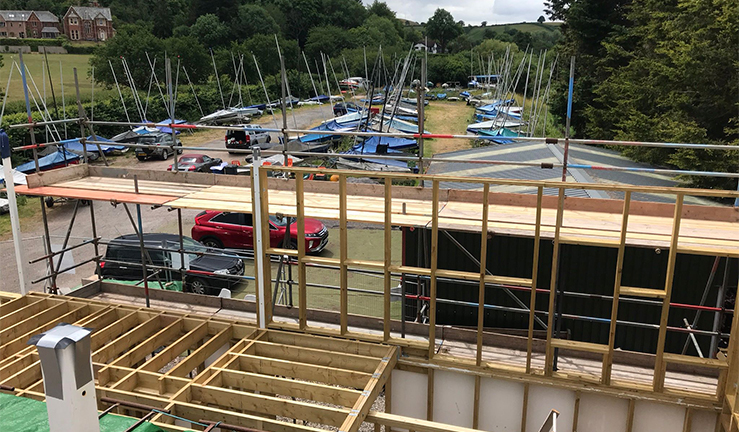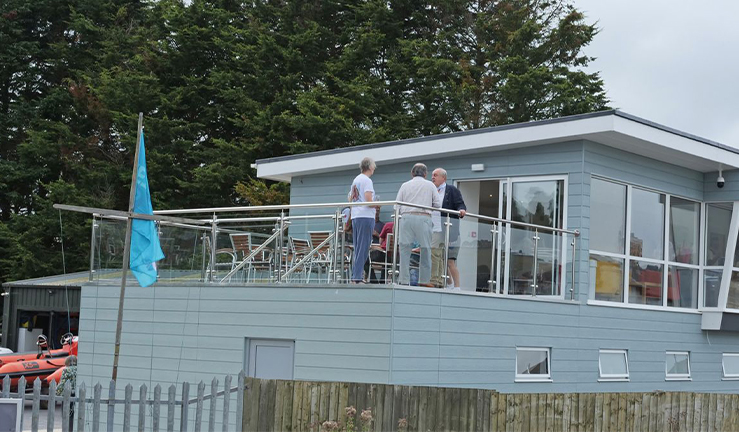A clubhouse built by volunteers
If at first you don't succeed...
Ben Miles has been working on the project since spring 2015, when he became Rear Commodore Dinghies and his daughter Millie pointed out how unfair it was to have such a large male changing room compared to the girls changing room! Ben began to review the facilities. The wooden, single storey 1940s club building had been lovingly refurbished many times over the years, but with changing space for 19 men and 6 women, it was far from suitable for a 21st century sailing club. “I could hear parents talking about other clubs with better facilities,” says Ben. “We were on the verge of losing members despite how fantastic the sailing is on the river Teign estuary, so we had to do something.”
During one of the Dinghy Section’s regular Wednesday morning discussions, club member and retired builder James Stevenson casually mentioned to Ben that he could build a new clubhouse with a second storey for £150,000 - the cost of materials - with no charge for his labour. Ben confirmed he could raise the money and went to the management committee to discuss fundraising.

Funding
The funding team engaged professional fundraiser Stuart Jones and put in an application to Sport England to part-fund the project. The process took nine months, and included a very positive site visit, but eventually the Sport England architectural team’s minimum sizes conflicted with the footprint of the clubhouse, which was restricted by the local council, and the funding was refused in September 2018.
Determined not to give up, Ben had heard about Exe Sailing Club, who set up a loan agreement with their members to raise capital for their own build project. TCYC had some money in reserves, and, still working on the £150,000 budget, they made a plan to borrow £75,000 from members, offering a 3% interest rate over a ten-year period, ensuring that the contribution from any one member was £2,500, £5,000, £7,500 or £10,000, with annual repayments after the second anniversary. Fortunately, another club member, retired banker Peter Hearne, was able to draw up an excellent loan agreement for the committee and members to use.
Very quickly, the committee was offered over £130,000 from members, so they were massively oversubscribed, and some members subsequently converted their loan into a gift!
Meanwhile Ben and the funding team carried on with funding applications. When Viridor Waste Management reopened a local waste site in early 2019, the team applied for £50,000 of community funding. They also went for a grant of £10,000 from the South Devon Coastal Local Action Group (SDCLAG), an organisation that mostly offers funding for local employment in agricultural settings. Despite the apparent mismatch, Ben managed to make his bid relevant: “We proved we could generate the equivalent of 2.4 local full-time employees (spread amongst sailing instructors running courses throughout the season) which is why we got the money. We wouldn’t be able to employ so many instructors without our new facilities.”
The club was awarded £50,000 from Viridor, and the SDCLAG fund developed into 40% of the initial build cost quote! As Ben explains, it took a lot of paperwork: “The application process finished in September 2019 and we had to jump through lots of hoops as these are central government-distributed European Union funds – but we got around £56,000!”
As the time went by, James’s original £150,000 quote for materials increased, not least because the final design had to include a £20,000 lift, balustrades, and a £30,000 electrical fitout, so the building cost £206,000 in all. However, with the funding from SDCLAG as well as Viridor all costs have been covered, thanks to £86,000 of club funds, £9,000 of members’ gifts and £5,000 district council funding.
While the membership loans were a catalyst to get on with the project then and there, with the final costs covered, the club has now substantially paid back the loans, way ahead of time.
Volunteers
Ben describes how crucial the volunteers have been: “The new clubhouse has largely been built by James Stevenson and two long-standing members, Peter Hearne and Andy Colyer who were at the club almost as much as James. There were also six or seven other volunteers at the club – all skilled, capable, able sailors with highly meticulous standards. They all supported James in a socially distanced way to help progress the build, throughout 2020. James turned 70 during this time, and just cracked on through the lockdowns. A further team of members handled the myriad of paperwork required to finance the project. If we’d gone out to architects and employed a building firm, it probably would have cost over £600,000 – I am eternally grateful to these fantastic volunteers; they let nothing stop them from succeeding and have been an excellent example to many. We’d never have been able to do it without them.
“One of the biggest hurdles has been spending the right money on the right things, as specified in the funding applications. But we’ve gone from just scraping by to getting a clubhouse with all the bells and whistles you could ask for!”
The last part of the project was to landscape the site: “Our training room only held 12 people before social distancing, so our landscaping idea included socially distanced external teaching spaces in order to future-proof the club,” says Ben. “The committee agreed to spend a further £30,000 of club funds to ensure that it was all done before mud and winter made a mess of the brand-new clubhouse. Everything has been an absolute dream.”

Opening the new clubhouse
To avoid crowding and minimise the covid risk, the club ran its opening event over two days on 25 and 26 September. All the funders were invited for the Saturday, together with representatives of local schools, groups and clubs, plus the harbourmaster. As Ben puts it: “The invitation to all these 120 non-members was our advert, so that they all know we now have a fantastic new building. We ended having 50-60 people dropping in between 3pm and 6pm to meet the build team and volunteers, who gave tours of the changing rooms and facilities, during which wine and exquisite canapés were served by our Rear Commodore Cruisers Steve Pocock and his wife Dee. People were amazed and surprised. The man from Viridor was seriously impressed and said that it’s a truly iconic building – which is a real compliment to everybody, especially James. The Chairman of SDCLAG was also very impressed – as it’s a rural fund, it is very rare to see such a membership-orientated facility rather than a barn for cows!”
The Sunday was a members’ invitation day and well over 100 members attended, including people who gifted money. One lady, whose son is now in his 60s but sailed at TCYC when he was a young teen, enjoyed the view from one of the new chairs and declared her gift very worthwhile. Ben is keen to point out that the club has a huge history of local people who have known it since it was a field with an old caravan to change in and watched it become what it is now, and they’re all behind it and positive. There have been no dissenting words from anyone.
The club class boat is a Solo, and the first club event with the new facilities was a Solo training day provided by eight-times National Solo Champion Charlie Cumbley, who is also a Life Member of TCYC. Ben reports: “Everyone was blown away by the changing rooms! It’s been a long project, but a real step change and very professional.”
Ben offers a few final words of advice for anyone looking to fund a club project: “Don’t aim low! There’s money available if you want to find it, you’ve just got to be creative and flexible to make your project fit whatever the funders are looking for.
“Also, I am the only one of the volunteer team who works full-time; the resource of retired members with the skills, experience and, most importantly, the time contributed to how we were able to build the facility. Every club will have retired members who I believe are looking for a project to get stuck into. These members are a hugely under-used resource. Very often they just need to be asked if they can help.”
If your club would like some advice on funding or upgrading facilities log into the Club Zone area on the RYA website for a wealth of guidance and information.
